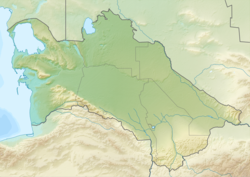Meane Baba mausoleum
| Meane Baba mausoleum | ||
|---|---|---|
 |
||
| Data | ||
| place | near the place Dushak | |
| Architectural style | Seljuk architecture | |
| Construction year | 11th century | |
| Floor space | about 100 m² | |
| Coordinates | 37 ° 11 '39 " N , 60 ° 0' 46" E | |
|
|
||
The Meane Baba Mausoleum is a building from the 11th century in the Turkmen province of Ahal and serves as the tomb of the Sufi Abu Sa'id .
location
The Meana Baba mausoleum is located near the place Dushak in the Karakum desert . The M37 trunk road runs to the north and runs eastwards from Türkmenbaşy on the Caspian Sea via the capital, Ashgabat . The immediate vicinity of the mausoleum is largely uninhabited today and is shaped by the desert landscape of the Karakum. The Meane Baba mausoleum used to be in the town of Mehne , which profited from trading on the Silk Road . After the city was given up due to lack of water, only the mausoleum of the former settlement remains today. This is maintained by the local population. Even today travelers and pilgrims visit the mausoleum.
Building history
The famous Sufi Abū Saʿīd lived in Central Asia from 968 to 1049 and is considered one of the most important Sufis and a great philosopher . Work on his mausoleum began soon after his death and thus fell into the heyday of the Seljuq dynasty , who ruled a large empire in Central and Western Asia in the 11th and 12th centuries . The Meane Baba Mausoleum is considered to be one of the most important examples of Seljuk architecture . The mausoleum was partially renovated in the 14th century , but large parts of the original structure were preserved.
Due to its architectural and historical importance, the Meane Baba mausoleum has been the subject of archaeological research since the 20th century.
description
The building has a square floor plan with a side length of around 10 meters, so that the floor area is around 100 square meters. The roof structure, which consists of two domes, is characteristic of the building . The entrance is built in the form of a Pishtak and was largely designed in its current form during the renovation in the 14th century. During this construction work, a colorful mosaic of blue, green and turquoise tiles was also added around the main entrance. The rest of the building has remained almost unchanged since the construction of the mausoleum in the 11th century. Inside the mausoleum there are several Arabic inscriptions on the walls, and there is an eight-pointed star on the inside of the dome.
Individual evidence
- ↑ Highlights / Ahal. Owadan Tourism, accessed November 12, 2019 .
- ^ Mean-baba mausoleum. Retrieved November 12, 2019 .
- ↑ Meane Baba Mausoleum. Retrieved November 12, 2019 .
- ↑ Turkmenistan - Ahal - Meane Baba. Stantours.com, accessed November 12, 2019 .
- ↑ Mausoleum Of Abu Said Meikhene - Meane Baba. Retrieved November 12, 2019 .
- ↑ Beate Luckow: Meane Baba mausoleum near Kahka . In: Turkmenistan . 1st edition. Trescher Verlag, Berlin 2006, ISBN 3-89794-061-2 , p. 141–143 ( books.google.de - reading sample).
